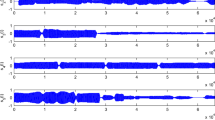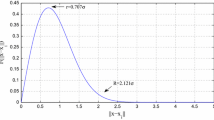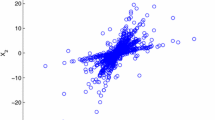Abstract
Under the circumstances that source signals are sufficiently sparse, an algorithm based on density measurement for blind estimation of the underdetermined mixing matrix is proposed in this paper. The proposed algorithm can estimate the number of source signals and the mixing matrix of the transmission channel simultaneously without any prior information. There are mainly three steps, including the preprocessing of observed samples, reservation of high-density samples, and estimation of the mixing matrix. Compared with the existing algorithms such as fuzzy clustering algorithm and probability density-based algorithm, the proposed algorithm does not require many iterations, which improves the efficiency. Simulation results show that the proposed algorithm has obvious advantages in the aspects of estimation accuracy of the mixing matrix as well as computational complexity and robustness.










Similar content being viewed by others
References
Qian, G., Li, L., & Luo, M. (2014). On the blind channel identifiability of MIMO-STBC systems using noncircular complex fastica algorithm. Circuits Systems & Signal Processing, 33(6), 1859–1881.
Pedersen, M.-S., Wang, D., Larsen, J., et al. (2008). Two-microphone separation of speech mixtures. IEEE Transactions on Neural Networks, 19(3), 475–492.
Pendharkar, G., Naik, G.-R., & Nguyen, H.-T. (2014). Using blind source separation on accelerometry data to analyze and distinguish the toe walking gait from normal gait in itw children. Biomedical Signal Processing and Control, 13(5), 41–49.
Yu, X.-C., Xu, J.-D., Hu, D., et al. (2013). A new blind image source separation algorithm based on feedback sparse component analysis. Signal Processing, 93(1), 288–296.
Miettinen J., Nordhausen K., Sara Taskinen. Blind source separation based on joint diagonalization in R: The Packages JADE and BSSasymp. http://ydl.oregonstate.edu/pub/cran/web/packages/JADE/vignettes/JADE-BSSasymp.pdf.
Naik, G.-R., Kumar, D.-K., & Palaniswami, M. (2014). Signal processing evaluation of myoelectric sensor placement in low-level gestures: Sensitivity analysis using independent component analysis. Expert Systems, 31(1), 91–99.
Chen, H.-P., Zhang, H., & Zhang, J. (2013). Retrospective on-line EASI blind source separation algorithm. Journal of Signal Processing, 4, 24–31.
Georgiev, P., Theis, F., & Cichocki, A. (2005). Sparse component analysis and blind source separation of underdetermined mixtures. IEEE Transactions on Neural Networks, 16(4), 992–996.
Ma, C., Yeo, T.-S., Liu, Z., et al. (2015). Target imaging based on ℓ 1 ℓ 0, norms homotopy sparse signal recovery and distributed MIMO antennas. Aerospace & Electronic Systems IEEE Transactions on, 51(4), 3399–3414.
Vidya, L., Vivekanand, V., Shyamkumar, U., et al. (2015). RBF-network based sparse signal recovery algorithm for compressed sensing reconstruction. Neural Networks, 63(C), 66–78.
Fu, W.-H., Nong, B., Chen, J.-H., et al. (2017). Source recovery in underdetermined blind source separation based on RBF network. Journal of Beijing University of Posts & Telecommunications, 15(1), 140–154.
He, X.-S., He, F., & Cai, W.-H. (2016). Underdetermined BSS based on K -means and AP clustering. Circuits Systems & Signal Processing, 35(8), 2881–2913.
Zhang, Y., Cao, K., Wu, K., et al. (2014). Audio-visual underdetermined blind source separation algorithm based on Gaussian potential function. China Communications, 11(6), 71–80.
Alshabrawy, O.-S., Ghoneim, M.-E., Awad, W.-A., et al. (2012). Underdetermined blind source separation based on Fuzzy C-Means and Semi-Nonnegative Matrix Factorization. In: Computer science and information systems (Vol. 11, pp. 695–700). IEEE.
Li, Y., Nie, W., Ye, F., et al. (2016). A mixing matrix estimation algorithm for underdetermined blind source separation. Circuits, Systems, and Signal Processing, 35(9), 3367–3379.
Li, Y., Nie, W., Ye, F., et al. (2016). A mixing matrix estimation algorithm for underdetermined blind source separation. Circuits Systems & Signal Processing, 35(9), 3367–3379.
Yang, Z.-Y., Tan, B.-H., Zhou, G.-X., et al. (2008). Source number estimation and separation algorithms of underdetermined blind separation. Science China Information Sciences, 51(10), 1623.
Sun, J., Li, Y., Wen, J., & Yan, S. (2016). Novel mixing matrix estimation approach in underdetermined blind source separation. Neurocomputing, 173(P3), 623–632.
Ester, M., Kriegel, H.-P., & Xu, X. (1996). A density-based algorithm for discovering clusters a density-based algorithm for discovering clusters in large spatial databases with noise. In Proceedings of the 1996 internationl conference on knowledge discovery and data mining (KDD ‘96) (pp. 226–231).
Funding
Funding was provided by National Nature Science Foundation of China (Grant No. 61201134) and the 111 Project (Grant No. B08038).
Author information
Authors and Affiliations
Corresponding author
Additional information
Publisher's Note
Springer Nature remains neutral with regard to jurisdictional claims in published maps and institutional affiliations.
Rights and permissions
About this article
Cite this article
Fu, W., Zhou, X., Nong, B. et al. Blind Estimation of Underdetermined Mixing Matrix Based on Density Measurement. Wireless Pers Commun 104, 1283–1300 (2019). https://doi.org/10.1007/s11277-018-6080-z
Published:
Issue Date:
DOI: https://doi.org/10.1007/s11277-018-6080-z




